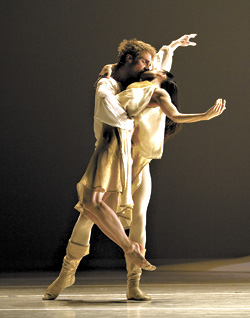Jean-Christophe Maillot’s Roméo et Juliette banishes significant parts of more traditional versions—no colonnaded sets or lavishly detailed costumes creating a Renaissance setting. Instead, we’ve got a set of blank panels shifting back and forth, making a series of open spaces for different scenes, and a collection of very soigné costumes that could find a home on Project Runway.
Maillot has also discarded several plot points and devices, but he more than makes up for that with the physicality of his characters, who bounce off each other until enough friction builds up and the inevitable takes place. Their movement language is emotionally direct and individual. The facility of ballet is still there—Mercutio is likely to whip off a series of multiple pirouettes to show his exuberance—but these skills work inside a physical world that is more grounded in realism. Dancers stand with their legs parallel and their arms hanging naturally at their sides as often as they pose with one leg pointed decorously to the front.
The ballet opens with Friar Laurence (who is much more than the usual benign cipher), writhing in some kind of torment. He slips in and out of scenes through the whole work, often commenting on the action, only rarely interacting with the other dancers. He becomes our guide—this story could be playing out in his memory. Flanked by two “acolytes” who seem to function like the “good angel/bad angel” on his shoulders, he yearns to make peace between the feuding characters, but has no power over the story as it plays out.
Maillot has created an elaborate set of gestures: Hands “swimming” in parallel, which symbolize the strife in the community, shift when Roméo and Juliette meet—their hands “swim” together. In the balcony scene, Juliette’s hand is like an independent thing, seeking contact and leading her to Roméo. And at the end of the first act, in one of the most poignant moments of the work, she leans forward, eyes closed and arm reaching out to the side as he quietly slips away, leaving her fingers dancing in the air, still looking for him.
Ernest Pignon-Ernest’s set is simple but effective. His moving screens focus our attention on the dancers rather than the decor, and a ramp across the back of the stage has multiple uses, as a roadway during the market scenes and a “ladder” to Juliette’s balcony. Dominique Drillot has created a very subtle lighting design, including a set of projections that suggest architectural elements and natural effects—Roméo and Juliette seem to dance under the northern lights during the balcony pas de deux. Some of Jérôme Kaplan’s costumes owe as much to the knit sheaths of early modern dance as they do to the Renaissance, with Asian elements as well.
With a ballet this emotional, casting is everything. As the young lovers, Noelani Pantastico and Lucien Postlewaite are heartbreakingly believable, squirming with excitement as they discover each other. Jonathan Porretta was born to play roles like Mercutio, as his natural theatricality feeds the character’s heedless rush to death. But the real star turn is Olivier Wevers as Friar Laurence, who is there at the beginning and at the end—predicting the tragedy and acting as the ultimate witness.








